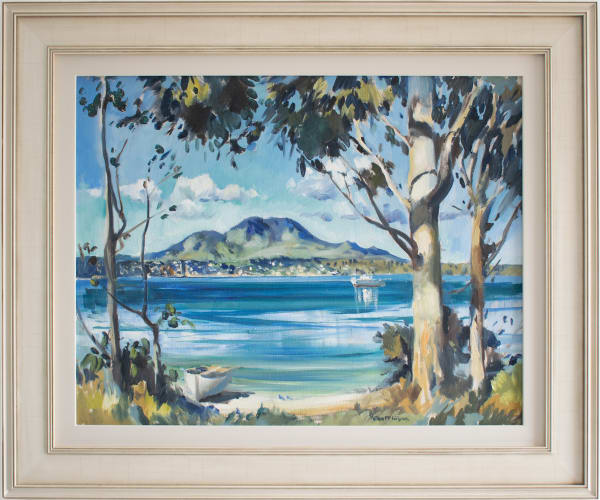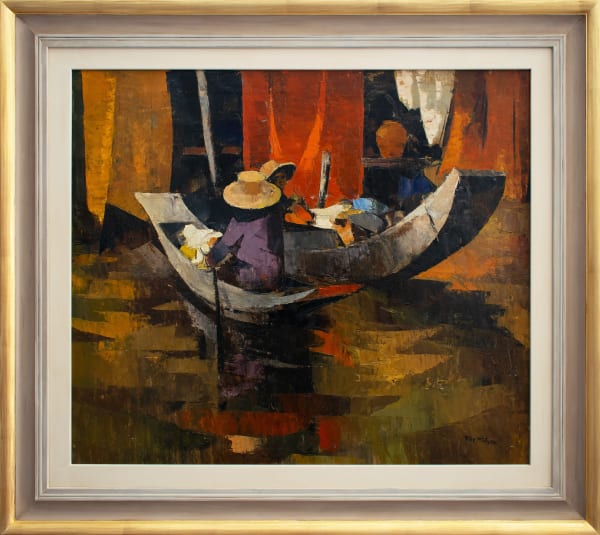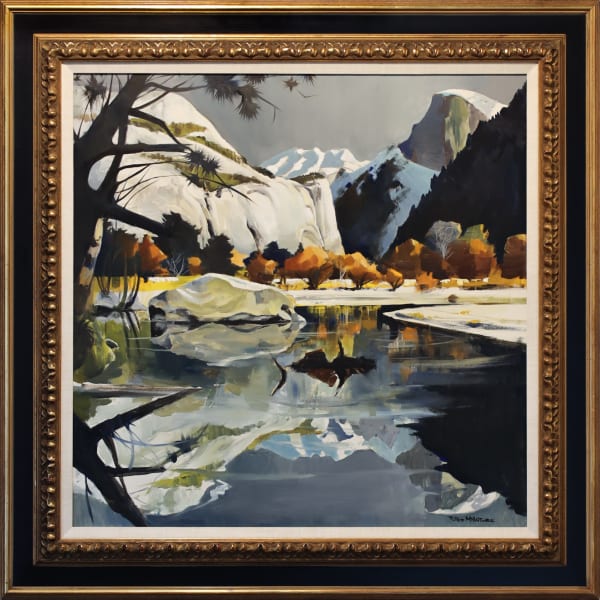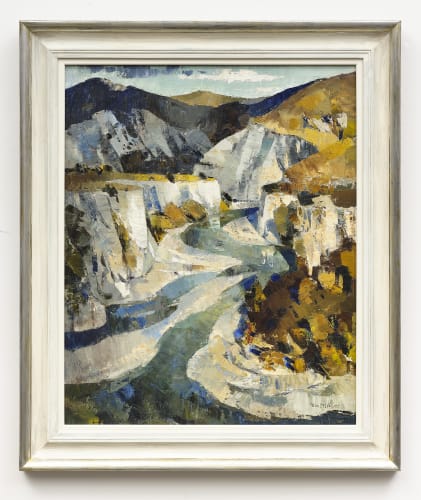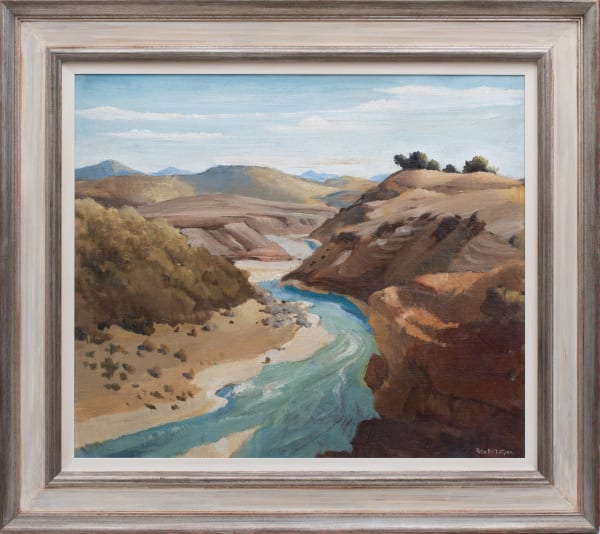Peter McIntyre New Zealand, 1910-1995
-
 Peter McIntyreWellington HarbourWatercolour72 x 89 cm (framed)
Peter McIntyreWellington HarbourWatercolour72 x 89 cm (framed)
53 x 72 cm (unframed)Signed -
 Peter McIntyreWhite Cliffs, Rangitikei RiverOil on Canvas board50 x 60 cmSigned lower right
Peter McIntyreWhite Cliffs, Rangitikei RiverOil on Canvas board50 x 60 cmSigned lower right -
 Peter McIntyreEntrance to the Bay of IslandsOil on canvas75 x 86 cm (framed)
Peter McIntyreEntrance to the Bay of IslandsOil on canvas75 x 86 cm (framed)
54 x 65 cm (unframed)Signed -
 Peter McIntyreTau Hara Taupo from Acacia Bay, 1957Oil on canvas board67 x 82.5 cm (framed)
Peter McIntyreTau Hara Taupo from Acacia Bay, 1957Oil on canvas board67 x 82.5 cm (framed)
48 x 62 cm (unframed)Signed lower right -
 Peter McIntyreThai Silk DryingOil on canvas86.5 x 97 cm (framed)
Peter McIntyreThai Silk DryingOil on canvas86.5 x 97 cm (framed)
60 x 75 cm (unframed)Illustrated Peter McIntyre's Pacific plate 37Signed -
 Peter McIntyreThe Awatere, MarlboroughOil on canvas board71 x 57.5 cmIllustrated Peter McIntyre's New Zealand plate 37Signed
Peter McIntyreThe Awatere, MarlboroughOil on canvas board71 x 57.5 cmIllustrated Peter McIntyre's New Zealand plate 37Signed -
 Peter McIntyreChurch Bay, TutukakaOil on canvas board49 x 75 cmSigned
Peter McIntyreChurch Bay, TutukakaOil on canvas board49 x 75 cmSigned -
 Peter McIntyreOkawa Bay, Lake RotoitiWatercolour69.5 x 79.5 cm (framed)
Peter McIntyreOkawa Bay, Lake RotoitiWatercolour69.5 x 79.5 cm (framed)
54 x 73 cm (unframed)Signed -
 Peter McIntyreAberdeen, Hong KongOil on board82.5 x 92.5 cm (framed)
Peter McIntyreAberdeen, Hong KongOil on board82.5 x 92.5 cm (framed)
65.5 x 75.5 cm unframedIllustrated Peter McIntyre's Pacific plate 34Signed -
 Peter McIntyreAnchor Bay, TawharanuiOil on board44.5 x 60 cmSigned lower right
Peter McIntyreAnchor Bay, TawharanuiOil on board44.5 x 60 cmSigned lower right -
 Peter McIntyreBuckingham PalaceOil on canvas51.5 x 69 cmSigned
Peter McIntyreBuckingham PalaceOil on canvas51.5 x 69 cmSigned -
 Peter McIntyreEvening Sun, Rangitikei RiverOil on canvas39 x 49.5 cmSigned lower right
Peter McIntyreEvening Sun, Rangitikei RiverOil on canvas39 x 49.5 cmSigned lower right -
 Peter McIntyreFrosty Morning, GallowayOil on board60 x 75 cmSigned 'Peter McIntyre' lower right c. 1950
Peter McIntyreFrosty Morning, GallowayOil on board60 x 75 cmSigned 'Peter McIntyre' lower right c. 1950 -
 Peter McIntyreIn the Lindis Pass, Central OtagoOil on canvas board70 x 90 cmSigned
Peter McIntyreIn the Lindis Pass, Central OtagoOil on canvas board70 x 90 cmSigned -
 Peter McIntyreKing Country and WoolshedOil on board51.5 x 71 cmPainting verso
Peter McIntyreKing Country and WoolshedOil on board51.5 x 71 cmPainting verso -
 Peter McIntyreManuherikia River, OtagoOil on canvas board59 x 74 cmSigned
Peter McIntyreManuherikia River, OtagoOil on canvas board59 x 74 cmSigned -
 Peter McIntyreYosemiteOil on canvas72 x 72 cmSigned lower right
Peter McIntyreYosemiteOil on canvas72 x 72 cmSigned lower right
Peter McIntyre is one of New Zealand’s most renowned artists, due to the ever popular presence of his books in the private libraries of New Zealand families.
McIntyre grew up in a creative environment in Dunedin, with his artistic pursuits avidly supported by his artist father, who signed him up for painting lessons under Dunedin artist Alfred O’Keeffe. After noticing his son’s lack of interest in a Bachelor of Arts at the University of Otago, McIntyre’s father encouraged him to study art at the Slade School of Art in London. Whilst at the Slade, McIntyre thrived from the study of old masters, such as Raphael and Ingres, and received several prizes in drawing and composition during his final year.
Following the completion of his studies, McIntyre worked as a commercial artist in Britain and became heavily influenced by the European avant-garde movements that developed in the 1930s, particularly Cubism. When war broke out in 1939, McIntyre enlisted as a gunner with the 34th Anti-tank Battery, a New Zealand volunteer unit formed in London. Sent to Egypt with his platoon, McIntyre was soon contributing illustrations to the British war magazine Parade.
In January 1941, General Freyberg learned of McIntyre’s painting talent and duly appointed him New Zealand’s official war artist, chronicling the activities of 2nd NZEF throughout Europe and North Africa. These images became a frequent presence in magazines such as Illustrated London News and the New Zealand Listener, causing McIntyre’s paintings to quintessentially represent the experiences of New Zealand soldiers in the Second World War. These works documented the campaigns of ANZAC troops in Crete, North Africa, Tripoli and Italy, and are now held at the National Archives in Wellington.
McIntyre returned to New Zealand in February 1946 as a respected and established artist, setting up a studio in Dunedin to quickly become a renowned portrait and landscape painter. His artworks from the war had toured both during and after the Second World War, causing McIntyre to become a familiar face in the press and on television.
Despite the financial difficulties experienced by full-time artists in New Zealand, McIntyre’s friendship with then-Governor General Freyberg provided him with valuable support as well as substantial patronage. McIntyre also served on the council of the New Zealand Academy of Fine Arts from 1959 until 1964, during which time he won numerous national art competitions; the Kelliher Art Award (1959); the watercolour section of the National Bank Art Awards (1960); as well as the Hay’s Art Competition (1962).
Following these successes, McIntyre began writing and illustrating books between 1962 and 1981, beginning with an illustrated biography entitled The Painted Years in 1962. His book Peter McIntyre’s New Zealand was released in 1964 and was so popular that it sold out within six days. McIntyre undertook numerous trips around the globe including Antarctica, Hong Kong, the Pacific, and the American West, writing and illustrating books documenting his experiences.
McIntyre became a particularly popular painter in the United States in 1971 following the release of West. His ability to capture the spirit and atmosphere of a scene and infuse peopleless scenes with anthropomorphic character, caused his paintings to be highly sought after.
McIntyre’s contribution to New Zealand art history was recognised in December 1970 with an OBE for his work as an author and for his accomplishment in the fine art fields. A retrospective show of McIntyre’s war paintings was held at the Wellington City Gallery in 1995 to popular acclaim. His work is held in numerous private and public collections, including those of the National Army Museum in Waiouru, Te Papa, and the Auckland War Memorial Museum, however it is McIntyre’s paintings of New Zealand cities and landscape which continue to make him one of the most recognisable and respected New Zealand artists of the twentieth century.
-

Spring
15 Sep - 29 Oct 2025Read more -

Landscapes
1 Apr - 21 May 2024Read more -

Peter McIntyre
31 Oct - 20 Nov 2023From October 31st to November 20th 2023 , Jonathan Grant Gallery hosted this captivating exhibition, showcasing McIntyre’s impactful pieces that have become integral to New Zealand’s artistic heritage. McIntyre’s paintings,...Read more -

Peter McIntyre
29 Jun - 18 Jul 2021Peter McIntyre is one of New Zealand’s most renowned artists, due to the ever popular presence of his books in the libraries of New Zealand families. McIntyre grew up in...Read more -

Peter McIntyre - Hong Kong
14 Feb - 10 Mar 2013Peter McIntyre was born in Dunedin in 1910. The son of a painter and graphic artist, McIntyre rose to become one of New Zealand’s most popular and celebrated artists of...Read more




